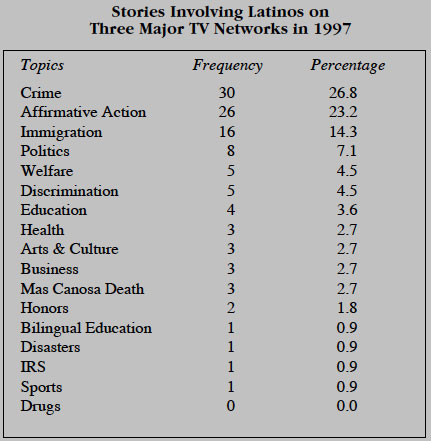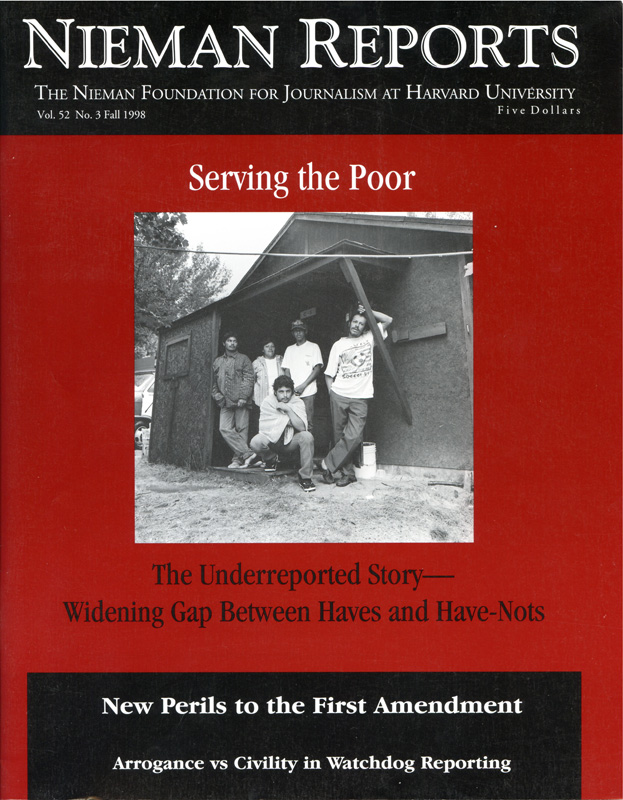AUTHOR’S NOTE
* “No Chicanos on TV” lyrics by Lalo Guerrero
Used by permission.Composer/singer Lalo Guerrero wrote his parody of the Joyce Kilmer poem a few years ago, but his lyrics still resonate. Just consider the recent dismal findings of a study, “Network Brownout 1998: The Portrayal of Latinos on Network Television News,” released this summer by the National Association of Hispanic Journalists.
Only 112 of the approximately 12,000 news stories produced by ABC, NBC and CBS Network News in 1997 and broadcast on their flagship evening newscasts focused on Latinos or Latino issues. In other words, a measly 1 percent of the total national TV evening news programming was devoted to coverage of 10 percent of the United States population; a dynamic, rapidly growing group estimated by the Census Bureau to number 29 million now, and projected to increase to 40 million or 13 percent of Americans by the year 2010 and as many as 66 million by 2030.
There are Chicanos in real life
doctors, lawyers, husbands, wives
but all they show us on TV
are ‘illegal aliens’ as they flee…
This last year the only Hispanic name to appear in the news with any regularity was El Niño. As for humans, out of a total of 546 hours of network news aired in 1997, only 4 hours and 40 minutes focused on Hispanics. The bulk (64 percent) of this already limited coverage dealt with crime, immigration and affirmative action. Only 14 stories ‘No Chicanos on TV’ (12 1/2 percent) were about Latinos’ rising influence in politics, business, arts and culture.
Stories originated primarily on the West Coast and Southwest states of the U.S. In addition, some markets with significant Latino populations (New York, Miami, Chicago) were underrepresented. NBC aired the most stories on Hispanics (50 stories). ABC aired 45 stories and CBS trailed with 44 stories.
It seems as if we don’t exist,
and we are not ever even missed…
This limited and oftentimes negative portrayal of Latinos is just plain wrong and has serious consequences for society. A recent survey by the child advocacy group, Children Now, revealed that youngsters of all races agree that the news media tend to portray African-American and Latino people more negatively than white and Asian people. The report noted that, when asked about how the news covered Hispanics, a Latino child responded “only when they get arrested.”
The lack of visibility of Latino news stories and Latino news subjects is not only a social problem, it also raises questions about the quality of journalism practiced by the networks. If journalism is supposed to hold up a mirror to society and it is not reflecting Hispanics, with all their worth, with all their warts, with all their contributions, then the networks are not practicing good journalism.
Hispanics have made notable achievements in many fields: In science, Raul Cano at California Polytechnic in San Luis Obispo is a pioneer on ancient DNA research. In the law, several Latinos are seen as potential Supreme Court nominees. They include U.S. Appeals Court Judge Jose A. Cabranes of New Haven, Carlos F. Lucero of Denver, U.S. District Judges Ruben Castillo of Chicago, Richard Paez of Los Angeles and Sonia Sotomayor of New York. Plus former California Supreme Court Justice Cruz Reynoso and Los Angeles lawyer Vilma S. Martinez. In business, Carlos Saladrigas, Chairman of the Miami-based employee management firm Vincam Group Inc., has led his company to become the first billion dollar Hispanic business. In literature, there is a Latino boom with writers like Sandra Cisneros, Julia Alvarez, Francisco Goldman, Esmeralda Santiago, Rosario Ferre, Oscar Hijuelos and many others. There are top Latino experts on medicine, the arts, politics, sports, in every field of human endeavor. Yet on network news Hispanics are all but invisible in providing expertise beyond Latino-related issues. The “Brownout Report” shows that in 1997 Hispanics appeared as “experts” in stories related to Latinos five times. Only two were interviewed on a mainstream topic: Professor Arturo Alvarez-Buylla on brain cell research and Executive Vice President of the AFL-CIO, Linda Chavez-Thompson, on gender equity.
In real life we are all around
all kinds of TV shows abound
but no Chicanos can be found
The National Association of Hispanic Journalists sponsors this report because as journalists we care about good journalistic practices and as Hispanics we want to make sure that the networks don’t persist in rendering us invisible. In the three years we have conducted this research we had hoped to see some improvement but, sadly, Latino coverage in network news is stuck at the 1 percent level as far as frequency is concerned and the limited ways in which we are portrayed persist. Figures are equally low at CNN, although the cable network and Fox News were not included in this study, which started out by looking at the three major network’s evening newscasts only. In order to keep the research “clean” we have kept it that way.
We also examined employment of Latinos in network news operations. ABC, CBS, NBC and CNN were surveyed about the number of Latinos employed in a variety of network news categories (from management to technicians). Only CNN supplied the specific information we requested. The information we did receive suggested that Latinos in “gatekeeper” roles (assignment editors, producers, news managers, etc.) were underrepresented in network news employment. The image of Latinos should improve with the hiring of more people of Hispanic heritage in these roles.
Ever since we launched this project we have sent copies of the report to the presidents of the network news divisions, but have received no response. This year we are asking for a meeting so we can explore some solutions. Obviously we want to increase the number of Hispanics before the cameras. Only five Latino correspondents made it into the evening news in 1997 (Jim Avila of NBC, Art Rascon and Vince Gonzalez of CBS, Antonio Mora and John Quinones of ABC). Perhaps more importantly, we want Latinos in key gatekeeper positions, where coverage decisions are made.
Diversity of points of view is essential. We at NAHJ are willing to help. One of our priority projects is the compilation of a Latino Source Book with the names of recognized experts in a variety of fields. When completed we will make it available to news media.
Don’t buy the products if you don’t see
No Chicanos on TV
It is going to take time, but demographic shifts will eventually change this situation. The networks are facing a tremendous challenge as they watch their audience share shrink. Hispanics are a dynamic people, gaining in political clout, with an estimated purchasing power of $300 billion a year, and projected to become the largest minority group in the 21st Century. Out of enlightened self-interest one of these days one of the networks is going to figure out that it wants to attract Hispanic viewers, that this is one way to grow their audience. And how will they do it? By ending the “network brownout” that unfairly renders Latinos invisible on the nation’s airwaves.

“Network Brownout 1998: The Portrayal of Latinos on Network Television News,” Rod Carveth, former Chair of the Mass Communication Department at the University of Bridgeport, and Diane Alverio, Baldwin/Alverio Media Marketing, former President of the National Association of Hispanic Journalists. Sponsors are the National Association of Hispanic Journalists and the National Council of La Raza. Copies of the full study may be purchased for $10 from the National Association of Hispanic Journalists, National Press Building, Suite #1193, Washington, D.C. 20045.
 Cecilia Alvear, a 1989 Nieman Fellow, is Vice President-Broadcast of the National Association of Hispanic Journalists and a Producer with NBC News.
Cecilia Alvear, a 1989 Nieman Fellow, is Vice President-Broadcast of the National Association of Hispanic Journalists and a Producer with NBC News.


